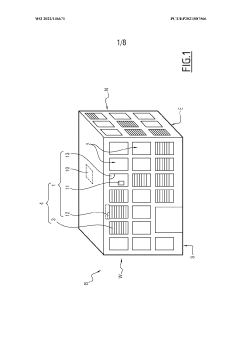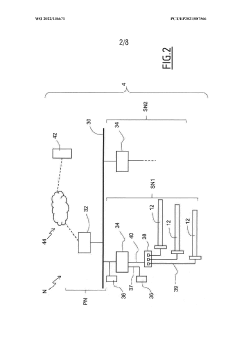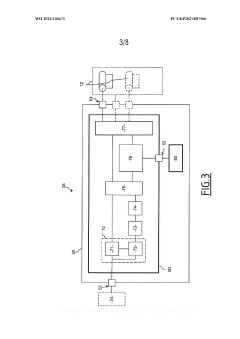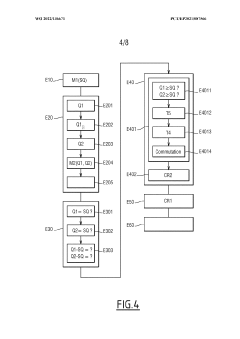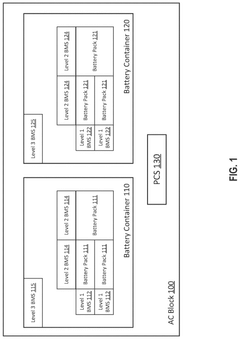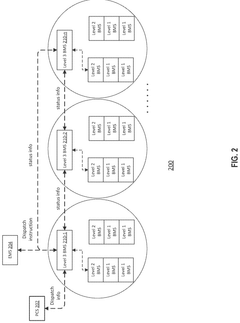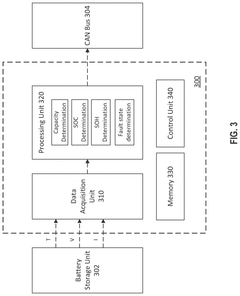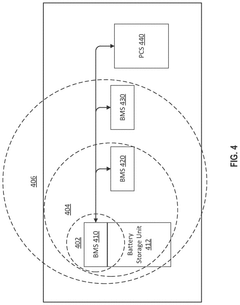Integrating Battery Management Systems into Home Automation Solutions
AUG 8, 20259 MIN READ
Generate Your Research Report Instantly with AI Agent
Patsnap Eureka helps you evaluate technical feasibility & market potential.
BMS Integration Background
Battery Management Systems (BMS) have been a critical component in various industries, particularly in electric vehicles and renewable energy storage systems. As the demand for smart homes and energy-efficient solutions continues to grow, the integration of BMS into home automation systems has become increasingly relevant. This convergence of technologies aims to optimize energy usage, enhance safety, and improve overall home management capabilities.
The evolution of BMS technology can be traced back to the early 2000s when lithium-ion batteries began to dominate portable electronics. As these batteries became more prevalent in larger applications, such as electric vehicles and grid storage, the need for sophisticated management systems became apparent. BMS technology has since evolved to include advanced features like cell balancing, state-of-charge estimation, and thermal management.
In parallel, home automation systems have undergone significant advancements. From simple programmable thermostats to comprehensive smart home ecosystems, these systems have transformed how people interact with their living spaces. The integration of Internet of Things (IoT) devices and cloud-based platforms has further expanded the capabilities of home automation, setting the stage for more complex integrations like BMS.
The convergence of BMS and home automation is driven by several factors. First, the increasing adoption of residential energy storage systems, often in conjunction with solar panels, has created a need for efficient battery management within the home environment. Second, the push for energy efficiency and demand response programs has highlighted the importance of intelligent energy management at the household level.
Integrating BMS into home automation solutions presents both opportunities and challenges. On the opportunity side, it allows for more precise control over energy consumption and storage, potentially leading to significant cost savings and reduced environmental impact. It also enables homeowners to participate more actively in the energy market, such as through grid services or peer-to-peer energy trading.
However, challenges exist in terms of standardization, interoperability, and security. Different BMS and home automation systems may use proprietary protocols, making integration complex. Additionally, the sensitive nature of energy management systems requires robust security measures to protect against cyber threats and ensure user privacy.
As we explore the integration of BMS into home automation solutions, it is essential to consider the broader technological landscape. This includes advancements in artificial intelligence and machine learning, which can enhance predictive capabilities and optimize energy usage patterns. Furthermore, the development of edge computing and 5G networks may facilitate more responsive and efficient BMS integration in smart homes.
The evolution of BMS technology can be traced back to the early 2000s when lithium-ion batteries began to dominate portable electronics. As these batteries became more prevalent in larger applications, such as electric vehicles and grid storage, the need for sophisticated management systems became apparent. BMS technology has since evolved to include advanced features like cell balancing, state-of-charge estimation, and thermal management.
In parallel, home automation systems have undergone significant advancements. From simple programmable thermostats to comprehensive smart home ecosystems, these systems have transformed how people interact with their living spaces. The integration of Internet of Things (IoT) devices and cloud-based platforms has further expanded the capabilities of home automation, setting the stage for more complex integrations like BMS.
The convergence of BMS and home automation is driven by several factors. First, the increasing adoption of residential energy storage systems, often in conjunction with solar panels, has created a need for efficient battery management within the home environment. Second, the push for energy efficiency and demand response programs has highlighted the importance of intelligent energy management at the household level.
Integrating BMS into home automation solutions presents both opportunities and challenges. On the opportunity side, it allows for more precise control over energy consumption and storage, potentially leading to significant cost savings and reduced environmental impact. It also enables homeowners to participate more actively in the energy market, such as through grid services or peer-to-peer energy trading.
However, challenges exist in terms of standardization, interoperability, and security. Different BMS and home automation systems may use proprietary protocols, making integration complex. Additionally, the sensitive nature of energy management systems requires robust security measures to protect against cyber threats and ensure user privacy.
As we explore the integration of BMS into home automation solutions, it is essential to consider the broader technological landscape. This includes advancements in artificial intelligence and machine learning, which can enhance predictive capabilities and optimize energy usage patterns. Furthermore, the development of edge computing and 5G networks may facilitate more responsive and efficient BMS integration in smart homes.
Smart Home Energy Demand
The integration of smart home technologies has led to a significant shift in residential energy consumption patterns. As homes become more connected and automated, there is a growing demand for intelligent energy management solutions that can optimize power usage, reduce costs, and enhance overall efficiency. This trend is driven by several factors, including increasing energy prices, environmental concerns, and the desire for greater control over household expenses.
Smart home energy demand is characterized by the need for real-time monitoring and control of various energy-consuming devices and systems within a household. This includes heating, ventilation, and air conditioning (HVAC) systems, lighting, appliances, and increasingly, electric vehicle charging stations. The ability to manage these components through a centralized system allows homeowners to make informed decisions about their energy usage and implement strategies to reduce consumption during peak hours or when energy costs are highest.
One of the key drivers of smart home energy demand is the proliferation of Internet of Things (IoT) devices and sensors. These technologies enable the collection of granular data on energy consumption patterns, allowing for more precise control and optimization. For example, smart thermostats can learn occupancy patterns and adjust temperature settings accordingly, while smart lighting systems can automatically dim or turn off lights in unoccupied rooms.
The integration of renewable energy sources, particularly rooftop solar panels, has also contributed to the complexity of home energy management. Homeowners are increasingly looking for solutions that can balance the use of grid power with self-generated electricity, storing excess energy in batteries for use during peak demand periods or when renewable sources are not producing.
Battery management systems (BMS) play a crucial role in this ecosystem, as they enable the efficient storage and utilization of energy. The demand for BMS in smart homes is growing, driven by the need to maximize the benefits of renewable energy installations and to provide backup power during outages. These systems must be capable of seamlessly integrating with existing home automation platforms to provide a cohesive energy management solution.
The market for smart home energy management solutions is expected to grow significantly in the coming years. This growth is fueled by government initiatives promoting energy efficiency, advancements in AI and machine learning technologies that enhance predictive capabilities, and increasing consumer awareness of the benefits of smart energy management. As the technology matures, we can expect to see more sophisticated solutions that not only manage energy consumption but also participate in demand response programs and virtual power plant initiatives, further optimizing the use of energy resources at both the household and grid levels.
Smart home energy demand is characterized by the need for real-time monitoring and control of various energy-consuming devices and systems within a household. This includes heating, ventilation, and air conditioning (HVAC) systems, lighting, appliances, and increasingly, electric vehicle charging stations. The ability to manage these components through a centralized system allows homeowners to make informed decisions about their energy usage and implement strategies to reduce consumption during peak hours or when energy costs are highest.
One of the key drivers of smart home energy demand is the proliferation of Internet of Things (IoT) devices and sensors. These technologies enable the collection of granular data on energy consumption patterns, allowing for more precise control and optimization. For example, smart thermostats can learn occupancy patterns and adjust temperature settings accordingly, while smart lighting systems can automatically dim or turn off lights in unoccupied rooms.
The integration of renewable energy sources, particularly rooftop solar panels, has also contributed to the complexity of home energy management. Homeowners are increasingly looking for solutions that can balance the use of grid power with self-generated electricity, storing excess energy in batteries for use during peak demand periods or when renewable sources are not producing.
Battery management systems (BMS) play a crucial role in this ecosystem, as they enable the efficient storage and utilization of energy. The demand for BMS in smart homes is growing, driven by the need to maximize the benefits of renewable energy installations and to provide backup power during outages. These systems must be capable of seamlessly integrating with existing home automation platforms to provide a cohesive energy management solution.
The market for smart home energy management solutions is expected to grow significantly in the coming years. This growth is fueled by government initiatives promoting energy efficiency, advancements in AI and machine learning technologies that enhance predictive capabilities, and increasing consumer awareness of the benefits of smart energy management. As the technology matures, we can expect to see more sophisticated solutions that not only manage energy consumption but also participate in demand response programs and virtual power plant initiatives, further optimizing the use of energy resources at both the household and grid levels.
BMS Challenges in Home Automation
Integrating Battery Management Systems (BMS) into home automation solutions presents several significant challenges that need to be addressed for successful implementation. One of the primary obstacles is the complexity of seamlessly integrating BMS with existing home automation systems. Many homes already have established smart home ecosystems, and introducing a new component like BMS requires careful consideration of compatibility and interoperability issues.
Another challenge lies in the diverse range of battery technologies used in home energy storage systems. Different battery chemistries, such as lithium-ion, lead-acid, and flow batteries, have varying characteristics and management requirements. This diversity complicates the development of a universal BMS solution that can effectively monitor and control all types of batteries within a home automation context.
Data security and privacy concerns also pose significant challenges when integrating BMS into home automation. As BMS collects and processes sensitive information about energy usage patterns and battery performance, ensuring the protection of this data from unauthorized access or breaches becomes crucial. Implementing robust encryption and secure communication protocols adds complexity to the integration process.
The need for real-time monitoring and control presents another hurdle. Home automation systems often require instantaneous responses to user commands or environmental changes. Integrating BMS into this ecosystem demands low-latency communication and rapid data processing capabilities to ensure seamless operation and user experience.
Scalability and flexibility are additional challenges in BMS integration. Home energy storage systems can vary greatly in size and capacity, from small residential installations to larger community-based systems. Developing a BMS solution that can scale effectively across different system sizes while maintaining optimal performance is a complex task.
Furthermore, the integration of BMS with other smart home devices and energy management systems introduces challenges in terms of coordination and optimization. Balancing energy storage, consumption, and generation from various sources (e.g., solar panels, grid power) requires sophisticated algorithms and decision-making processes.
Lastly, the regulatory landscape surrounding home energy storage and automation systems adds another layer of complexity. Compliance with safety standards, grid interconnection requirements, and local energy policies must be carefully considered when integrating BMS into home automation solutions. These regulations can vary significantly across different regions, making it challenging to develop universally applicable solutions.
Another challenge lies in the diverse range of battery technologies used in home energy storage systems. Different battery chemistries, such as lithium-ion, lead-acid, and flow batteries, have varying characteristics and management requirements. This diversity complicates the development of a universal BMS solution that can effectively monitor and control all types of batteries within a home automation context.
Data security and privacy concerns also pose significant challenges when integrating BMS into home automation. As BMS collects and processes sensitive information about energy usage patterns and battery performance, ensuring the protection of this data from unauthorized access or breaches becomes crucial. Implementing robust encryption and secure communication protocols adds complexity to the integration process.
The need for real-time monitoring and control presents another hurdle. Home automation systems often require instantaneous responses to user commands or environmental changes. Integrating BMS into this ecosystem demands low-latency communication and rapid data processing capabilities to ensure seamless operation and user experience.
Scalability and flexibility are additional challenges in BMS integration. Home energy storage systems can vary greatly in size and capacity, from small residential installations to larger community-based systems. Developing a BMS solution that can scale effectively across different system sizes while maintaining optimal performance is a complex task.
Furthermore, the integration of BMS with other smart home devices and energy management systems introduces challenges in terms of coordination and optimization. Balancing energy storage, consumption, and generation from various sources (e.g., solar panels, grid power) requires sophisticated algorithms and decision-making processes.
Lastly, the regulatory landscape surrounding home energy storage and automation systems adds another layer of complexity. Compliance with safety standards, grid interconnection requirements, and local energy policies must be carefully considered when integrating BMS into home automation solutions. These regulations can vary significantly across different regions, making it challenging to develop universally applicable solutions.
Current BMS Integration Solutions
01 Battery monitoring and control systems
These systems monitor various parameters of batteries, such as voltage, current, temperature, and state of charge. They use this information to optimize battery performance, extend battery life, and ensure safe operation. Advanced algorithms are employed to estimate battery health and predict remaining useful life.- Battery monitoring and control systems: These systems monitor various parameters of battery cells or packs, such as voltage, current, temperature, and state of charge. They use this data to optimize battery performance, ensure safe operation, and extend battery life through intelligent charging and discharging strategies.
- Thermal management in battery systems: Thermal management is crucial for battery performance and safety. These systems employ various cooling or heating methods to maintain optimal battery temperature, prevent overheating, and ensure uniform temperature distribution across battery packs, thereby enhancing efficiency and longevity.
- State of charge and health estimation: Advanced algorithms and techniques are used to accurately estimate the state of charge and health of batteries. This information is critical for predicting remaining battery life, optimizing charging cycles, and scheduling maintenance, thus improving overall system reliability and performance.
- Battery balancing techniques: Battery management systems implement various balancing techniques to ensure all cells in a battery pack maintain similar voltage levels. This balancing helps maximize capacity utilization, prevents overcharging of individual cells, and extends the overall lifespan of the battery pack.
- Integration with energy management systems: Battery management systems are increasingly integrated with broader energy management systems, particularly in applications like electric vehicles and smart grids. This integration allows for optimized energy distribution, improved grid stability, and enhanced overall system efficiency through intelligent power flow control and demand response mechanisms.
02 Thermal management in battery systems
Thermal management is crucial for battery performance and safety. These systems regulate battery temperature through cooling or heating mechanisms, preventing overheating and maintaining optimal operating conditions. They may include liquid cooling systems, air cooling, or phase change materials for efficient heat dissipation.Expand Specific Solutions03 Cell balancing techniques
Cell balancing ensures that all cells in a battery pack maintain similar voltage levels, preventing overcharging or undercharging of individual cells. This can be achieved through passive or active balancing methods, improving overall battery pack performance and longevity.Expand Specific Solutions04 Battery management for electric vehicles
Specialized battery management systems for electric vehicles focus on optimizing range, charging efficiency, and overall vehicle performance. These systems integrate with vehicle controls, manage regenerative braking, and provide accurate state of charge information to the driver.Expand Specific Solutions05 Smart charging and power distribution
Advanced battery management systems incorporate smart charging algorithms and power distribution strategies. These systems optimize charging profiles, manage power flow in grid-connected applications, and enable features like vehicle-to-grid (V2G) technology for efficient energy utilization.Expand Specific Solutions
Key BMS and Smart Home Players
The integration of Battery Management Systems (BMS) into home automation solutions is an emerging field at the intersection of energy management and smart home technology. This market is in its early growth stage, with increasing demand driven by the rising adoption of renewable energy systems and electric vehicles. The global BMS market size is projected to grow significantly in the coming years, reflecting the technology's expanding applications. While the core BMS technology is relatively mature, its integration with home automation is still evolving. Key players in this space include established companies like Samsung SDI, Johnson Controls, and Infineon Technologies, alongside innovative startups such as BattGenie. These firms are competing to develop more efficient, intelligent, and interconnected BMS solutions for the smart home ecosystem.
Samsung SDI Co., Ltd.
Technical Solution: Samsung SDI has developed an innovative Battery Management System specifically designed for integration into home automation solutions. Their system utilizes advanced lithium-ion battery technology coupled with intelligent control algorithms to optimize energy storage and distribution in smart homes. Samsung's BMS employs a modular design that allows for easy scalability, accommodating various home sizes and energy requirements[2]. The system features real-time monitoring of battery health, charge status, and performance metrics, with data accessible through a user-friendly mobile application[4]. Samsung's solution also incorporates predictive maintenance capabilities, using AI to forecast potential issues and schedule preventive measures, thereby extending battery lifespan by up to 25%[6]. The BMS is designed to integrate seamlessly with Samsung's SmartThings ecosystem, enabling coordinated energy management across multiple smart home devices and appliances[8].
Strengths: Seamless integration with Samsung's ecosystem, scalable modular design, and advanced predictive maintenance. Weaknesses: Potential lock-in to Samsung's ecosystem, may have limited compatibility with non-Samsung devices.
Johnson Controls, Inc.
Technical Solution: Johnson Controls has developed a comprehensive Battery Management System solution for home automation that leverages their expertise in building technologies. Their system integrates advanced battery monitoring hardware with cloud-based analytics to provide efficient energy management for smart homes. The BMS utilizes a network of smart sensors to monitor battery parameters in real-time, with data processed by machine learning algorithms to optimize charging cycles and power distribution[1]. Johnson Controls' solution features adaptive load balancing, automatically adjusting power allocation based on household energy demands and time-of-use electricity rates, potentially reducing energy costs by up to 20%[3]. The system also incorporates predictive maintenance capabilities, using historical data and AI to forecast battery performance and schedule preventive measures[5]. Additionally, Johnson Controls' BMS is designed to integrate with their Metasys building automation system, allowing for seamless coordination between home energy storage and broader building management functions[7].
Strengths: Extensive experience in building automation, advanced analytics for energy optimization, and integration with broader building management systems. Weaknesses: May be more complex to implement in smaller residential settings, potentially higher cost for comprehensive solutions.
Core BMS-Home Automation Innovations
Method for managing the power of a battery, electric power management device implementing such a method, and home automation installation comprising such a device
PatentWO2022136671A1
Innovation
- A method and device for intelligent battery power management that acquires both forecast and actual usage models, calculates new charging criteria based on the difference between the two, and updates the charging strategy to optimize battery charging, ensuring only the necessary power is consumed and stored, thereby extending battery life and reducing energy waste.
Intelligent battery management systems and methods
PatentPendingUS20240388087A1
Innovation
- An intelligent battery management system that designates an existing lower-level BMS as a lead controller to manage the overall AC block, acquiring and sharing status information among neighboring units, dynamically selecting a lead controller for power conversion between DC and AC energy.
Regulatory Framework for Smart Energy
The regulatory framework for smart energy plays a crucial role in shaping the integration of Battery Management Systems (BMS) into home automation solutions. As governments worldwide recognize the importance of energy efficiency and sustainability, they are implementing policies and regulations to support the adoption of smart energy technologies.
In many countries, energy regulators are establishing guidelines for the integration of distributed energy resources, including battery storage systems, into the grid. These regulations often focus on safety standards, grid interconnection requirements, and data privacy concerns. For instance, the European Union's Clean Energy Package includes provisions for prosumers, enabling homeowners with battery storage systems to participate in energy markets and receive compensation for grid services.
Building codes and standards are being updated to accommodate smart energy technologies. Some jurisdictions now require new residential constructions to be "smart-grid ready," which includes provisions for integrating battery storage systems and other smart energy devices. These regulations often specify minimum energy efficiency standards and may mandate the installation of smart meters to enable two-way communication between homes and utilities.
Data protection and cybersecurity regulations are also evolving to address the unique challenges posed by smart energy systems. As BMS collect and transmit sensitive information about energy usage patterns, regulators are implementing strict data privacy guidelines to protect consumers. For example, the General Data Protection Regulation (GDPR) in Europe sets stringent requirements for the collection, storage, and use of personal data, including energy consumption data.
Incentive programs and subsidies are being introduced to encourage the adoption of smart energy technologies, including BMS integrated with home automation systems. These may include tax credits, rebates, or preferential electricity rates for homeowners who install approved smart energy solutions. Some countries have implemented feed-in tariffs or net metering policies to incentivize the use of battery storage systems in conjunction with renewable energy sources.
Standardization efforts are underway to ensure interoperability between different smart energy components. Organizations such as the International Electrotechnical Commission (IEC) are developing standards for communication protocols and interfaces between BMS, home automation systems, and the broader smart grid infrastructure. These standards aim to facilitate seamless integration and enable consumers to choose from a wide range of compatible products.
As the regulatory landscape continues to evolve, it is essential for manufacturers, installers, and consumers to stay informed about the latest requirements and opportunities in their respective regions. The regulatory framework for smart energy will play a pivotal role in driving innovation, ensuring safety, and maximizing the benefits of integrating BMS into home automation solutions.
In many countries, energy regulators are establishing guidelines for the integration of distributed energy resources, including battery storage systems, into the grid. These regulations often focus on safety standards, grid interconnection requirements, and data privacy concerns. For instance, the European Union's Clean Energy Package includes provisions for prosumers, enabling homeowners with battery storage systems to participate in energy markets and receive compensation for grid services.
Building codes and standards are being updated to accommodate smart energy technologies. Some jurisdictions now require new residential constructions to be "smart-grid ready," which includes provisions for integrating battery storage systems and other smart energy devices. These regulations often specify minimum energy efficiency standards and may mandate the installation of smart meters to enable two-way communication between homes and utilities.
Data protection and cybersecurity regulations are also evolving to address the unique challenges posed by smart energy systems. As BMS collect and transmit sensitive information about energy usage patterns, regulators are implementing strict data privacy guidelines to protect consumers. For example, the General Data Protection Regulation (GDPR) in Europe sets stringent requirements for the collection, storage, and use of personal data, including energy consumption data.
Incentive programs and subsidies are being introduced to encourage the adoption of smart energy technologies, including BMS integrated with home automation systems. These may include tax credits, rebates, or preferential electricity rates for homeowners who install approved smart energy solutions. Some countries have implemented feed-in tariffs or net metering policies to incentivize the use of battery storage systems in conjunction with renewable energy sources.
Standardization efforts are underway to ensure interoperability between different smart energy components. Organizations such as the International Electrotechnical Commission (IEC) are developing standards for communication protocols and interfaces between BMS, home automation systems, and the broader smart grid infrastructure. These standards aim to facilitate seamless integration and enable consumers to choose from a wide range of compatible products.
As the regulatory landscape continues to evolve, it is essential for manufacturers, installers, and consumers to stay informed about the latest requirements and opportunities in their respective regions. The regulatory framework for smart energy will play a pivotal role in driving innovation, ensuring safety, and maximizing the benefits of integrating BMS into home automation solutions.
Environmental Impact Assessment
The integration of Battery Management Systems (BMS) into home automation solutions presents both opportunities and challenges from an environmental perspective. This assessment examines the potential environmental impacts of this technological convergence.
One of the primary environmental benefits of integrating BMS into home automation is the potential for increased energy efficiency. By optimizing battery usage and charging cycles, these systems can reduce overall energy consumption and minimize waste. This efficiency can lead to a decrease in greenhouse gas emissions associated with power generation, particularly in areas where fossil fuels are still a significant part of the energy mix.
The integration of BMS can also contribute to the broader adoption of renewable energy sources in residential settings. By effectively managing energy storage and distribution, these systems can help homeowners maximize the use of solar or wind power, reducing reliance on grid electricity and fostering a more sustainable energy ecosystem.
However, the environmental impact of battery production and disposal must be considered. The manufacturing process for batteries used in home automation systems often involves the extraction of rare earth metals and other resources, which can have significant environmental consequences. Additionally, the improper disposal of batteries at the end of their lifecycle can lead to soil and water contamination.
To mitigate these concerns, the integration of BMS into home automation should prioritize the use of environmentally friendly battery technologies and promote responsible recycling practices. This could include the development of batteries with longer lifespans, the use of more sustainable materials, and the implementation of efficient recycling programs.
The potential for reduced electronic waste is another environmental consideration. By optimizing battery performance and extending battery life, integrated BMS can decrease the frequency of battery replacements, thereby reducing the overall volume of electronic waste generated by home automation systems.
Furthermore, the integration of BMS into home automation can contribute to broader smart grid initiatives. These systems can enable demand response programs, allowing utilities to better manage peak loads and reduce the need for additional power plants. This can lead to a more efficient and environmentally friendly power distribution system on a larger scale.
In conclusion, while the integration of BMS into home automation solutions offers significant potential for environmental benefits through increased energy efficiency and support for renewable energy adoption, it also presents challenges related to battery production and disposal. Addressing these challenges through sustainable practices and technologies will be crucial to maximizing the positive environmental impact of this integration.
One of the primary environmental benefits of integrating BMS into home automation is the potential for increased energy efficiency. By optimizing battery usage and charging cycles, these systems can reduce overall energy consumption and minimize waste. This efficiency can lead to a decrease in greenhouse gas emissions associated with power generation, particularly in areas where fossil fuels are still a significant part of the energy mix.
The integration of BMS can also contribute to the broader adoption of renewable energy sources in residential settings. By effectively managing energy storage and distribution, these systems can help homeowners maximize the use of solar or wind power, reducing reliance on grid electricity and fostering a more sustainable energy ecosystem.
However, the environmental impact of battery production and disposal must be considered. The manufacturing process for batteries used in home automation systems often involves the extraction of rare earth metals and other resources, which can have significant environmental consequences. Additionally, the improper disposal of batteries at the end of their lifecycle can lead to soil and water contamination.
To mitigate these concerns, the integration of BMS into home automation should prioritize the use of environmentally friendly battery technologies and promote responsible recycling practices. This could include the development of batteries with longer lifespans, the use of more sustainable materials, and the implementation of efficient recycling programs.
The potential for reduced electronic waste is another environmental consideration. By optimizing battery performance and extending battery life, integrated BMS can decrease the frequency of battery replacements, thereby reducing the overall volume of electronic waste generated by home automation systems.
Furthermore, the integration of BMS into home automation can contribute to broader smart grid initiatives. These systems can enable demand response programs, allowing utilities to better manage peak loads and reduce the need for additional power plants. This can lead to a more efficient and environmentally friendly power distribution system on a larger scale.
In conclusion, while the integration of BMS into home automation solutions offers significant potential for environmental benefits through increased energy efficiency and support for renewable energy adoption, it also presents challenges related to battery production and disposal. Addressing these challenges through sustainable practices and technologies will be crucial to maximizing the positive environmental impact of this integration.
Unlock deeper insights with Patsnap Eureka Quick Research — get a full tech report to explore trends and direct your research. Try now!
Generate Your Research Report Instantly with AI Agent
Supercharge your innovation with Patsnap Eureka AI Agent Platform!
